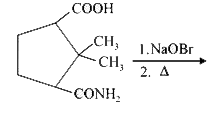If acetylene is reacted with an excess of sodium metal in hexane
and the reaction product is treated with 1-bromopropane ,
the final product will be
3-octene
4-octyne
8-octane
none of the above
The correct Answer is:B
To solve the problem step by step, we will analyze the reaction of acetylene with sodium metal in hexane and the subsequent reaction with 1-bromopropane.
Step 1: Reaction of Acetylene with Sodium Metal
Acetylene (C₂H₂) reacts with sodium metal (Na) in the presence of hexane. This reaction leads to the formation of a compound known as disodium acetylide.
Reaction:
2C2H2+2Na→Na2C2+2H2
Here, disodium acetylide (Na2C2) is formed.
Step 2: Reaction of Disodium Acetylide with 1-Bromopropane
Next, the disodium acetylide reacts with 1-bromopropane (C₃H₇Br). In this reaction, the sodium atoms in the disodium acetylide are replaced by the propyl groups from 1-bromopropane through a nucleophilic substitution reaction.
Reaction:
Na2C2+2C3H7Br→C2C(C3H7)2+2NaBr
Step 3: Structure of the Final Product
The resulting product from this reaction is 4-octyne. The structure can be visualized as follows:
- The original acetylene has two carbon atoms, and each sodium atom is replaced by a propyl group (C₃H₇).
- The final structure will have a total of 8 carbon atoms, with a triple bond between the second and third carbon atoms.
Final Product
Thus, the final product of the reaction is 4-octyne.
Summary of the Steps:
1. Acetylene reacts with sodium to form disodium acetylide.
2. Disodium acetylide reacts with 1-bromopropane, leading to the substitution of sodium with propyl groups.
3. The final product is 4-octyne.
Acetylene (C₂H₂) reacts with sodium metal (Na) in the presence of hexane. This reaction leads to the formation of a compound known as disodium acetylide.
2C2H2+2Na→Na2C2+2H2
Next, the disodium acetylide reacts with 1-bromopropane (C₃H₇Br). In this reaction, the sodium atoms in the disodium acetylide are replaced by the propyl groups from 1-bromopropane through a nucleophilic substitution reaction.
Na2C2+2C3H7Br→C2C(C3H7)2+2NaBr
The resulting product from this reaction is 4-octyne. The structure can be visualized as follows:
- The final structure will have a total of 8 carbon atoms, with a triple bond between the second and third carbon atoms.
Thus, the final product of the reaction is 4-octyne.
1. Acetylene reacts with sodium to form disodium acetylide.
2. Disodium acetylide reacts with 1-bromopropane, leading to the substitution of sodium with propyl groups.
3. The final product is 4-octyne.
Similar Questions
Acetylene is treated with excess sodium in liquid ammonia. The product is reacted with excess of methyl iodide. The final product is……………….
View SolutionIn the given reaction final product is

View Solutiono-Chloroaniline is treated with a mixture of NaNO2 and HCl and the product is reacted with cuprous bromide. The final product in the reaction will be
View SolutionAcetone is treated with excess of ethanol in the presence of hydrochloric acid. The product obtained is
View SolutionWhen excess of ethyl iodide is treated with ammonia, the product is
View SolutionMethane reacts with excess of chlorine is diffused sunlight to give the final product as
View SolutionWhen iodobenzene is treated with sodium in dry ether the product is
View SolutionThe final product of the reaction :

View SolutionPropene is allowed to react with B2D6 and the product is treated with acetic acid. The final product obtained is -
View SolutionPredict final products in the reactions

View Solution
